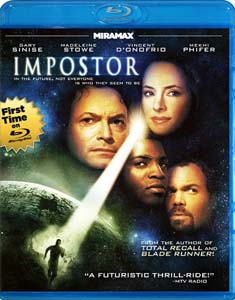“Impostor” (2002) is one of those PKD adaptations that turns an idea-driven short story into an action movie, but unlike some others, it doesn’t abandon the core story. Rather, it pads it out with action. Usually, to say a film is “padded” is not accurate; it’s a derogatory term rather than a descriptive term. But “Impostor” truly was intentionally padded out from a short film – envisioned as one of three 40-minute shorts packaged into one feature — into a feature-length film on its own.
Man on the run
The additional material finds Defense Department official Spencer Olham (Gary Sinise) on the run from authorities and teaming up with Cale (Mekhi Phifer), a Zoner who can sneak him back under the city’s dome so Spence can clear his name. It’s not too bad, but it’s basically “The Fugitive” in 2079, and “Impostor” sometimes looks more like a SyFy channel movie than a theatrical release.
The heart (no pun intended) of the movie is the question of whether Spencer is a human being or a replicant – with a nanobot bomb hidden in his heart — planted by the Centauri, with whom Earth is fighting a perpetual war (hence the protective domes).

“Impostor” (2002)
Director: Gary Fleder
Writers: Philip K. Dick, Scott Rosenberg, Caroline Case
Stars: Shane Brolly, Vincent D’Onofrio, Gary Sinise
In addition to bringing back the term “replicant,” director Gary Fleder’s “Impostor” is of a piece with “Blade Runner” via its question of “What differentiates replicants from humans?” It’s such a background question in “Blade Runner” that it’s almost beside the point — Rachael is a replicant and Deckard is (probably) human, but what really matters is that their feelings are real.
The question is foregrounded in “Impostor.” We spend the whole movie with Spence yet there’s no way to know if he’s human or replicant. (Unless we’ve read PKD’s story, but even then, there’s the chance the filmmakers could deliver a different ending.) In fact, Spence himself doesn’t know if he’s human or replicant.
Every piece of information could be answered either way. For example, Spence’s recent memory is fuzzy, so that could explain the time when the replicant killed the real Spence and took his place. But he is drugged when first captured by the authorities – led by Vincent D’Onofrio’s Hathaway – so his hazy memories could be from the drugs.
It sticks the landing
“Impostor” sticks the landing when the action moves to a spaceship crash site in the woods. The answer to the story’s big question is faithful to PKD’s version while also offering a surprise unique to the adaptation.
The writers – Scott Rosenberg and three others – arguably do a better job than PKD of explaining why the authorities can’t (or don’t) test Spence to see if he’s human or replicant. PKD doesn’t go into detail about the technology or physiology of replicants, but the movie explains that the bomb forms from nanobots that can’t be detected until it’s too late. As such, Hathaway relies on the decoding of plans stolen from the Centauri; these plans tell him Spence is an impostor.

The writers fudge things a little bit. Because Spence’s wife, Maya (Madeleine Stowe) is an elite doctor, Spence knows about an advanced scan that can perhaps detect the presence of nanobots. It’s strange that Hathaway and the authorities don’t know about this scan. At any rate, the scan turns out to be another piece of information that could go either way: Does the scan stop at Spence’s heart because of the bots, or because of a random equipment malfunction?
While 95 minutes isn’t a lot to sit through, “Impostor” would nonetheless be better if it was tighter. Sinise and D’Onofrio keep it from descending into cheese, but Fleder includes some annoying style touches such as brief slo-mo shots to indicate Spence’s confusion and the high stakes. And a love montage between Spence and Maya goes on longer than what’s needed to make its point.
A believable future
On the whole, the future of “Impostor” is communicated to viewers well, even if its stylistic palette is more generic than eye-popping. It’s set in 2079, but if it was set in 2019, it wouldn’t look laughably futuristic. Spence and Maya’s home life includes an Alexa-type device that controls the TV, stereo and shower. Government-run buildings have an ever-present security patrol, and when citizens are accosted by agents, they are annoyed but they accept that this is normal.
The bleakest aspect of this world is that there’s no doubt the Centauri will eventually win. Early in the film, a doomsayer looking through a telescope tells Spence with confidence that the Centauri will eventually destroy the dome; Spence disagrees, but without confidence. At the hospital, wounded soldiers keep pouring in.
But the biggest threat is the next-level tech that’s capable of creating a precise replica of Spence. That’s so far beyond what humans can create – even in 2079 – that it’s just a matter of time till the Earth is populated by the Centauri. It’s hard to stop an invasion when a person can’t be sure if he himself is human or an alien creation.

